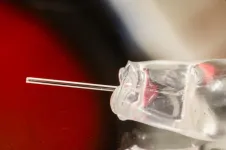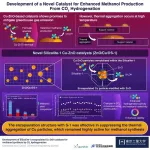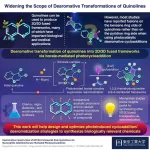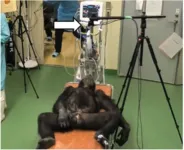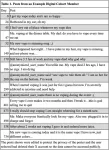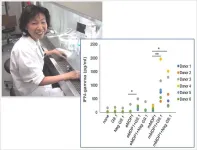(Press-News.org) When low doses of cancer drugs are administered continuously near malignant brain tumours using so-called iontronic technology, cancer cell growth drastically decreases. Researchers at Linköping University, Sweden, and the Medical University of Graz, Austria, demonstrated this in experiments with bird embryos. The results, published in the Journal of Controlled Release, is one step closer to new types of effective treatments for severe cancer forms.
Malignant brain tumours often recur despite surgery and post-treatment with chemotherapy and radiation. This is because cancer cells can “hide” deep within tissue and then regrow. The most effective drugs cannot pass through the so-called blood-brain barrier – a tight network surrounding blood vessels in the brain that prevents many substances in the blood from entering it. Consequently, there are very few available options for treating aggressive brain tumours.
In 2021, a research group from Linköping University and the Medical University of Graz demonstrated how an iontronic pump could be used to locally administer drugs and inhibit cell growth for a particularly malignant and aggressive form of brain cancer – glioblastoma. At that time, experiments were conducted on tumour cells in a petri dish.
Now, the same research group has taken the next step towards using this technology in clinical cancer treatment. By allowing glioblastoma cells to grow using undeveloped bird embryos, new treatment methods can be tested on living tumours. The researchers showed that the growth of cancer cells decreased when low doses of strong drugs (gemcitabine) were continuously administered using an iontronic pump directly adjacent to the brain tumour.
“We have previously shown that the concept works. Now we use a model with a living tumour, and we can see that the pump administers the drug very effectively. So even though it is a simplified model of a human, we can say with greater certainty that it works,” says Daniel Simon, professor of organic electronics at Linköping University.
The concept behind a future treatment for glioblastoma involves surgically implanting an iontronic device directly into the brain, close to the tumour. This approach allows for the use of low doses of potent drugs while bypassing the blood-brain barrier. Precise dosing, both in terms of location and timing, is crucial for effective treatment. Additionally, this method can minimize side effects since the chemotherapy doesn’t need to circulate throughout the entire body.
Beyond brain tumours, researchers hope that iontronics can be applied to many types of difficult-to-treat cancer forms.
“It becomes a very persistent treatment that the tumour cannot hide from. Even though the tumour and surrounding tissue try remove the drug, the materials and control systems we use in iontronics can continuously deliver a locally high concentration of medication to the tissue adjacent to the tumour,” explains Theresia Arbring Sjöström, a researcher at the Laboratory for Organic Electronics at Linköping University.
The researchers compared the continuous drug delivery of the pump with once-daily dosing, which more closely resembles how chemotherapy is administered to patients today. They observed that tumour growth decreased with the ionic treatment but not with the daily-dose approach, even though the latter was twice as strong.
These experiments were conducted using bird embryos at an early developmental stage. According to Linda Waldherr, a researcher at the Medical University of Graz and a guest researcher at LiU, this model serves as a good bridge to larger animal experiments:
“In bird embryos, certain biological systems function similarly to those in living animals, such as the formation of blood vessels. However, we don’t need to surgically implant any devices in them yet. This demonstrates that the concept works, although there are still many challenges to address,” she says.
The researchers believe that human trials could be feasible within the next five to ten years. The next steps involve further developing materials to allow for the surgical implantation of iontronic pumps. Subsequent experiments will also be conducted on rats and larger animals to further evaluate this treatment method.
END
More effective cancer treatment with iontronic pump
2024-06-19
ELSE PRESS RELEASES FROM THIS DATE:
Ultrasound beam triggers ‘nanodroplets' to deliver drugs at exactly the right spot
2024-06-19
Conventional drug delivery is often like cracking a nut with a sledgehammer. Whether the drug is swallowed, injected, inhaled, or absorbed through the skin, it ultimately diffuses to most parts of the body, including those where it isn’t needed – or where it even might cause harm.
But what if the delivery could be targeted at exactly the right spot? This would allow the total dose to be dramatically lower, thus minimizing side-effects.
Now, scientists from the US have found a way to perfect a promising, ...
Blessing in disguise: Mycoviruses enhance fungicide effectiveness against plant pathogens
2024-06-19
Osaka, Japan — As detrimental as viruses may sound, they can be helping hands for farmers when it comes to dealing with plant pathogens.
Osaka Metropolitan University scientists have discovered that a mycovirus that infects plant pathogenic oomycete Globisporangium ultimum can increase the latter’s sensitivity to specific fungicides. Their findings could lead to innovative approaches for controlling plant diseases, reducing reliance on chemical treatments, and minimizing agricultural loss.
Their results were published in Microbiological Research ...
A novel signal-amplification system utilizing sumanene-based supramolecular polymers
2024-06-19
Chemical sensors whose signals can be amplified by various triggers hold huge potential in multidisciplinary sciences. However, developing such systems was considered a highly challenging task, until a team of researchers from Tokyo Tech recently came up with a novel signal-amplification system that can be flexibly manipulated by a dynamic allosteric effector or a trigger. This new chemosensor system exhibited exception signal amplification by altering the sumanene monomer concentrations.
Synthetic supramolecular hosts and artificial receptors have found an exciting application in the form of chemical sensors or chemosensors, ...
Transforming inexpensive quinolines into complex drug candidates
2024-06-19
An innovative synthesis strategy opened up the way to 2D/3D fused frameworks using inexpensive quinolines as feedstock, report scientists from Tokyo Tech. By leveraging a light-sensitive borate intermediate, the scientists could transform quinoline derivatives into a great variety of 2D/3D fused frameworks in a straightforward and cost-effective manner. Their findings are expected to enable the synthesis of highly customizable drug candidates.
Quinolines have garnered much attention from chemists wanting to synthesize compounds known as 2D/3D fused frameworks. These complex organic molecules have a lot of medical potential due to their highly ...
Unlocking heart health: advancing noninvasive monitoring in chimpanzees
2024-06-19
Measuring the heart rate of great apes in captivity is essential for both health management and animal studies. However, existing most methods are either invasive or inaccurate. Now, researchers from Japan have investigated the potential of using millimeter-wave radar technology to estimate heart rate from subtle body movements in chimpanzees. Their efforts will hopefully pave the way to better practices and techniques for monitoring heart rates in wild and captive primates.
Just like in humans, heart rate is a critically important and informative vital sign in nonhuman primates. Heart diseases are among the main causes ...
Study uses powerful new ‘digital cohort’ method to understand vaping epidemic
2024-06-19
Tapping into the vast amount of data now available on social media, a new study from scientists at the University of California San Diego introduces a powerful new approach to understanding the nation’s health, in this case the vaping epidemic.
The study, published in the American Journal of Preventive Medicine on June 19, was led by John W. Ayers, Ph.D., from the Qualcomm Institute within UC San Diego.
“Researchers studying social media have tended to analyze the frequency and content of posts,” said Ayers, who is deputy director of informatics at the Altman Clinical and Translational Research Institute, vice chief of innovation in the Division of Infectious ...
A new tuberculosis vaccine candidate recombinant protein with additional post-translational modifications occurring in Mycobacterium tuberculosis cells
2024-06-19
Niigata, Japan - Tuberculosis is still one of the deadliest infectious diseases, causing over one million deaths each year worldwide. Additionally, about one-fourth of the world's population carries Mycobacterium tuberculosis (M. tuberculosis) without showing any symptoms, and most of these carriers do not develop the disease.
The current anti-tuberculosis vaccine, BCG, is administered worldwide. However, considering that more than 10 million new tuberculosis cases are reported each year, its effectiveness is deemed ...
Experts converge at USC Music, Health, and Policy workshop
2024-06-19
USC recently hosted its first Music, Health, and Policy workshop as part of Los Angeles County Arts and Health Week, filling Joyce J. Cammilleri Hall on the University Park Campus.
Event organizer Assal Habibi, an associate professor at the Brain and Creativity Institute at the USC Dornsife College of Letters, Arts and Sciences who explores the intersection between music and the human brain, brought together a wide range of experts on the importance of art and its effect on human development and well-being.
“The workshop aims to bring people together ...
Private school and/or ‘higher status’ university education linked to better mid-life health
2024-06-19
A private (fee-paying) school and/or a ‘higher status’ (Russell Group*) university education may be linked to better mid-life health—at least in the UK—suggests research published online in the Journal of Epidemiology & Community Health.
Alongside the level of education achieved, the type of educational institution a person attends may also influence subsequent health outcomes, suggest the researchers.
Published research to date indicates that educational attainment is associated with better subsequent health. But other aspects ...
Heavy resistance training around retirement preserves vital leg strength years later
2024-06-19
Twelve months of heavy resistance training—exercise that makes muscles work against a force—around retirement preserves vital leg strength years later, show the follow up results of a clinical trial, published online in the open access journal BMJ Open Sport & Exercise Medicine.
Depletion of leg muscle strength is regarded as a strong predictor of death in older people, so is important to maintain, say the researchers.
Skeletal muscle mass and function naturally decline with advancing age, ultimately often interfering with mobility and autonomy in older people, note the researchers.
Resistance training, which ...
